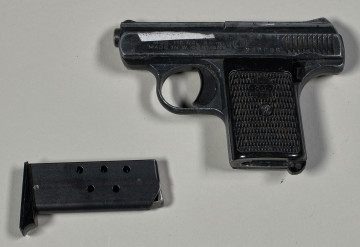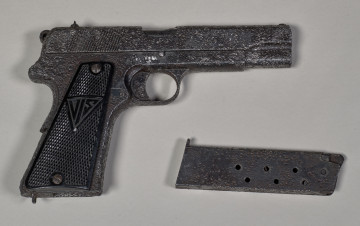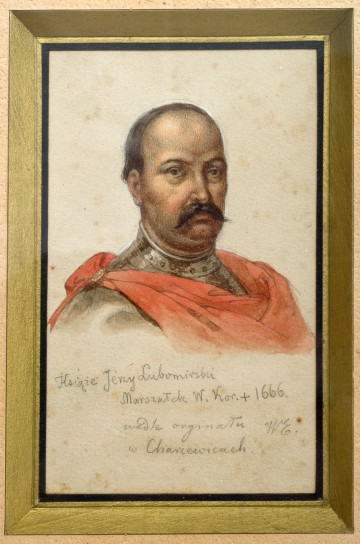
SM Pistol
1. połowa XX wieku
Castle Museum in Łańcut
Part of the collection: Weapons, music instruments, varia
The history of mankind is one great series of wars that causes changes, the fall of some superpowers and the rise of others on their ruins. Battlefields and armaments are subject to the same evolution as other areas of human life, and new "inventions" in the field of military science have been the cause of the collapse of many superpowers. One such "invention" was gunpowder and the advent of firearms, which changed the way war was fought, diminished the role of cavalry and increased the importance of infantry and artillery. Gunpowder (called black from its colour) was known in China in the 9th century AD, from where it came to Europe, where it gained popularity from the 13th century until the development of smokeless powder at the end of the 19th century. Gunpowder and its properties have led to the creation of firearms (projectile weapons), which, thanks to the energy of the burned powder (in the barrel), is capable of throwing a projectile over long distances. Despite their simplicity, the first types of firearms became the cause (in addition to the increasingly soft urbanization) of the decline in the importance of the cavalry, which was not very resistant to the fire of the new weapons. In order to increase the value of cavalry in this new world, work began on the development of new types of firearms (the first firearms were heavy, with a long barrel, and the loading process was long and required from the soldier to stand up), that was light and short enough to be loaded and fired from a horse. The first pistols (as this type of weapon was called) were the petronel, a weapon with a longer barrel, a wheel lock and a strongly bent gunstock equipped with a flat butt, which was used to rest the weapon against the cavalryman's chest during a shot. Cavalry formations using firearms were called arquebusiers (in Western Europe), and in the army of the Polish-Lithuanian Commonwealth they were called the armoured. The soldiers of these units had firearms, from which they fired while standing, leaning the barrel against the saddle of their own horse. These types of cavalry formations, called arquebusiers, were infantry moving on horseback and fighting on foot. The evolution of firearms in the cavalry through the introduction of bandolets (light long gun) led to the creation of pistols- weapons light enough to be able to fire with one hand. The first pistols equipped with a wheel lock (German and Italian type) were much shorter and lighter, with a strongly inclined grip (today it is a stock) ending with a fairly large head in the shape of a pear or egg. The ability to shoot from a horse with one hand resulted in the formation of a new cavalry formation called the caracol, which was popular from the second half of the 16th century to the mid-17th century. In the following years, pistols were equipped with various lock (flintlock, percussion cap) and their barrel and weight were reduced. After the introduction of breech-loading weapons (another type is a combined cartridge revolver), loading became faster and easier. The following centuries brought technological changes related to the production of weapons, such as increasing the firepower, range, accuracy (barrel rifling). The emergence of new types of weapons, which ultimately resulted in the reduction of the pistol or revolver (the effective range does not exceed 50 m. and the firepower is much lower than in other firearms) to the function of sidearm, personal weapon, additional weapon, e.g. for members of combat vehicle crews or functional soldiers. On the other hand, thanks to their not very large dimensions and weight, they are relatively easy to access, pistols are still very popular and most representatives of the services (Police, Border Guard) are equipped with them. In history, some models of pistols have gained more or less fame, you could mention the Mauser C96 pistol, the German Luger P08, the Polish VIS, Walteher PPK (James Bond's pistol), and without the Colt revolver (especially in cinema and pop culture) it is hard to imagine conquering the Wild West.
One of the symbols of Czechoslovakia in the interwar period was the weapon produced by the Ceska Zbrojovka factory. In these factories was produced a semi-automatic pistol, operating on the principle of short recoil operation, designated CZ 24, and modelled after the Mauser pistol cal. 7.65. Pistol dimentions: 159 x 90 mm, weight: 0.95 kg. The pistol was fed with a box magazine for 8 cartages of 9 mm calibre.
The copy of CZ 24 pistol (ser. no. 11584) comes from the collection of the Museum – Castle in Łańcut (inventory no. 13620/a,bMŁ) and is currently being prepared for exhibition in the City History Department. The location of the exhibition is not accidental, as this particular CZ 24 pistol was used during the war by second Lieutenant Jerzy Pelc-Piastowski (1927 – 2021) nom de guerre "Łazik". The second lieutenant had family ties to Łańcut and in this area he was active in the Underground State. During the German occupation, he was initially a member of the youth conspiracy in Łuków in Podlasie, wanted by the Gestapo in 1943, he took refuge in Łańcut (his family lived there) and hid until the Germans left in the summer of 1944. He was a truly committed soldier of the Home Army, he was active in the sabotage unit of Józef Lenar nom de guerre "Piłka". He took part in many important actions of the Łańcut underground: multiple acquisition of weapons and military supplies from German railway transports, securing an allied air drop in Rakszawa, and an attack on a German ferry crossing in Stare Miasto near Leżajsk. In June 1944, as a member of the partisan unit "Włodzimierz", he fought in the forests in the area of Brzyska Wola and Kuryłówka in Zasanie. After the invasion of the Red Army, he became a member of the second independence underground. Arrested by the UB in Lublin in August 1945, he was sentenced to six years in prison. Seriously wounded during transport to the prison in Wronki, finally granted amnesty in 1947.
Jerzy Pelc-Piastowski is a graduate of the Jagiellonian University, historian, journalist, publicist, author of numerous studies, articles and historical reportages, among others, books on the activities of the Łańcut District of the Home Army in the years 1943-1944 written on the basis of his own memories.
Przemysław Kucia
Author / creator
Object type
broń
Technique
rusznikarstwo
Material
metal
Creation time / dating
Owner
Muzeum - Zamek w Łańcucie
Identification number
Location / status

1. połowa XX wieku
Castle Museum in Łańcut

lata 30. XX w.
Castle Museum in Łańcut

XIX century
Castle Museum in Łańcut
DISCOVER this TOPIC
National Museum in Lublin
DISCOVER this PATH
Educational path